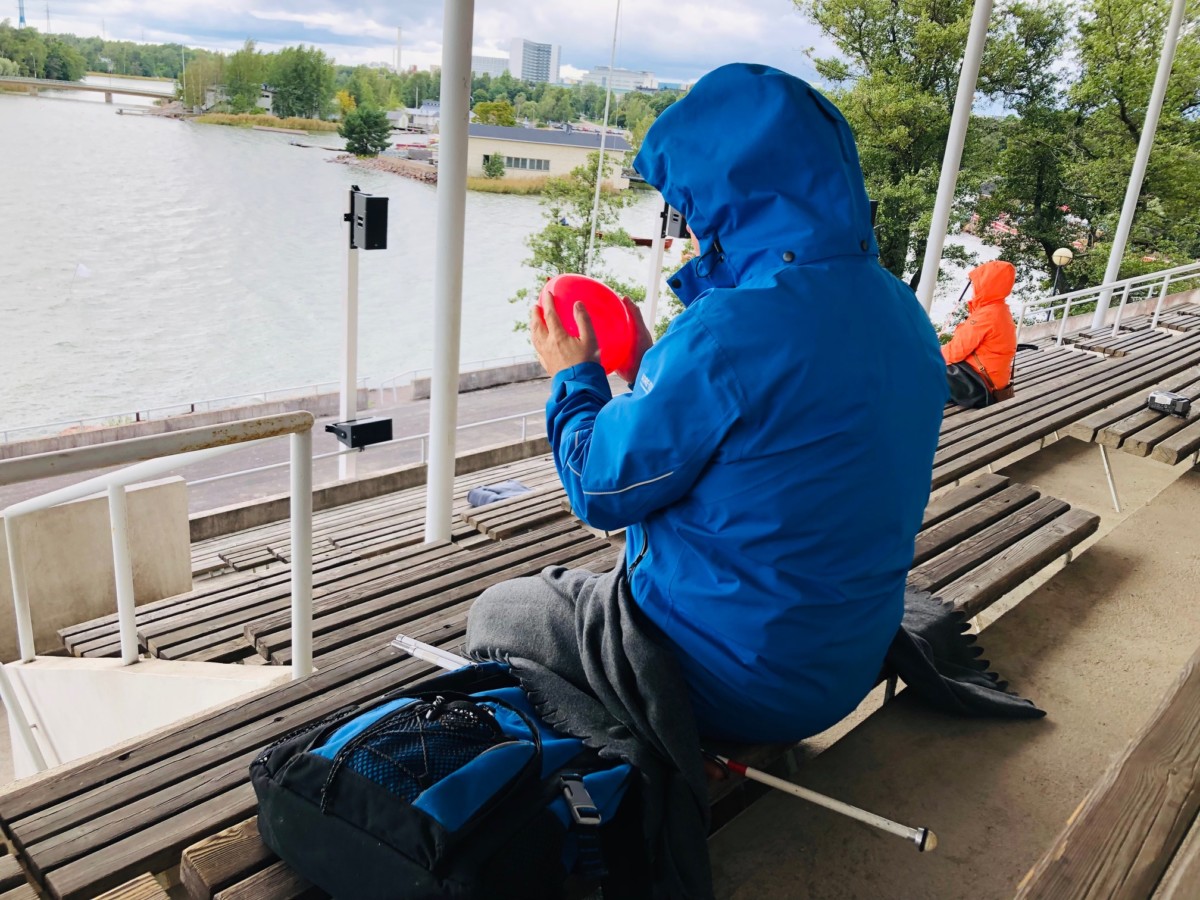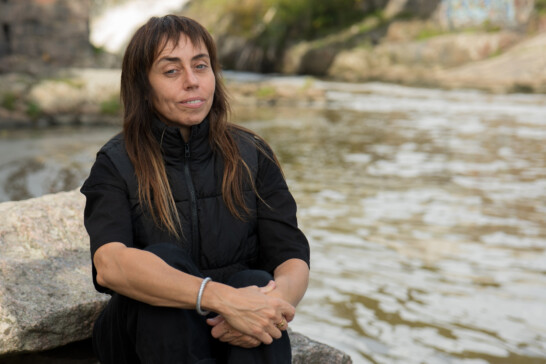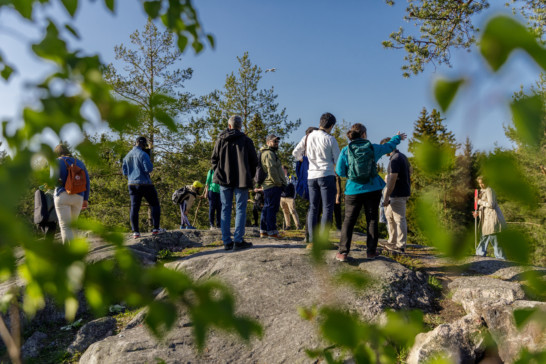News
Open your senses – Experiencing a sound installation with deafblind people

The core of IHME Helsinki’s work is producing art commissions by internationally established artists in public space. The temporary IHME Commissions speak to multiple senses at once, but what experiences do they produce in people with sensory impairments? We invited some special guests to the first IHME Helsinki Commissions, from whom we wanted to learn more about how we can improve the accessibility of IHME Commissions and make them more open to different target groups.
In autumn 2021, we staged two IHME Helsinki commissioned works, one based on sounds and the other on smells. In August, the Norwegian artist Jana Winderen’s sound installation Listening Through the Dead Zones, designed specifically for the site, Helsinki Rowing Stadium, brought the sound world of submarine animals to this outdoor grandstand. The Scottish artist Katie Paterson’s To Burn, Forest, Fire, conceived in September, was based on the fragrances of the Earth’s first forest and the last forest of the environmental crisis. The scents traced in collaboration with researchers have been refined into incense, which were burned in incense ceremonies in several locations in different parts of Helsinki.
IHME’s Executive Director Paula Toppila approached the members of three associations: The Finnish Deafblind Association; Helsinki and Uusimaa Visually Impaired Association; and Helsinki Association of the Deaf (Helsingin Kuurojen Yhdistys ry), whose members were invited to experience the works with their own groups. In addition, Toppila invited the music therapist Russ Palmer and the researcher and teacher of social-haptic communication Riitta Lahtinen, who both work with the Finnish Deafblind Association, to come to the audience workers’ induction days to tell them about meeting people with visual and hearing impairments.
Experiences of the visit to the soundwork by deafblind people
We approached the Finnish Deafblind Association specifically with the fragrance artwork in mind, but the group were also interested in Jana Winderen’s soundwork. We, too, were curious to hear what kind of experience they got from the work, which is based especially on the senses of sight and hearing. For the multilingual visit, we welcomed Sanna Nuutinen, the association’s communication worker, assisted by Päivi Mäki, a Finnish sign language interpreter, and Russ Palmer, to whom Riitta Lahtinen conveyed Finnish in English and by touch.
Before stepping into the Rowing Stadium’s grandstand we did some groundwork for the experience with a brief introduction, which was held in a quiet place sheltered from the wind, and where there was enough room to view sign language from the distance required by the coronavirus pandemic. IHME’s Cultural Producer Päivi Matala talked about Winderen’s work, in which the artist had brought together underwater sound recordings that she had made around the world’s waters. In the installation we heard the sounds of animals that live in water, such as whales, fish, shellfish and insects. Russ Palmer had brought with him miniature models of porpoises and whales to be touched, and through which we discussed the sea creatures that he already knew beforehand.
After the introduction, we headed for the rowing-stadium grandstand. The assistants played an important role in informing guests about uneven ground and the stadium’s numerous sets of steps. Sanna Nuutinen found herself a listening spot in the middle section of the grandstand, from where she concentrated the sound of the work and the view to the sea.
Meanwhile, Russ Palmer studied the artwork’s sounds, at first, by using the different channels of his cochlear implant, which make it possible to perceive different frequency bands one by one. Palmer also switched the device off to investigate the sounds by concentrating particularly on the vibrations that generate sound, which he could feel, for instance, in different parts of the grandstand with the aid of a bench and an inflated balloon. The vibrations could be felt especially strongly in front of the loudspeakers.
Riitta Lahtinen also interpreted the artwork with social-haptic communication by haptiering by touch on Palmer’s back, i.e using haptices, the rhythms and differences in pitch of the sounds in the sound installation. When sitting in the grandstand, you could also feel the coolness of the day that presaged rain and the smell of the sea carried by the wind.
Engagement draws people into an art experience
After the visit, we gathered once again to discuss the experience of the artwork. Palmer, who has investigated music and acoustics for his professional work, considered the artwork’s technical implementation to be of a high standard. We also discussed more about the installation of the work and the tradition of experimental music and sound art, in which Winderen’s art is also situated. Palmer’s experience ultimately consisted of a variety of imaginative ways of experiencing, which together formed an overall picture of the artwork, based in part on memories from the period before the impairment of vision and hearing.
Our other guest, Sanna Nuutinen, said she enjoyed the artwork in ways distinct from the perceptible world. A large portion of the work’s sounds are unrecognizable to the human ear, which, according to Nuutinen, also fed the imagination. The work prompted her to notice not only the diversity of sea creatures, but also the acoustics of water, and the wellbeing of the oceans in general.
Nuutinen, who turned out to be an inveterate exhibition-goer, said she particularly liked works and experiences that make use of multiple senses at once. The IHME Commissions had sparked curiosity, especially with the possibility of hearing and smelling, which also adds to the experience for people with sensory impairments: “If you just look at art with your eyes, then that is one thing, but if you don’t see anything, there is nothing you get from it.” According to her, in order to open up the background to the works, more advantage could be taken of various approaches, the experience of visual art usually lacks the possibility of touch.
Nuutinen raised the importance of a safe visiting experience. Apart from physical accessibility, this also involves the experience of being able to approach art without advance knowledge or a professional background. She praised Finnish cultural institutions for taking account of accessibility, albeit there is no single device for engaging the enthusiasm of visitors with sensory impairments: “There are people who like opera and people who like heavy music, and they are two different worlds. Ultimately it depends on the individual whether an artwork is interesting to them or not. There is neither a right way or a wrong way of experiencing it,” she says.
What did we learn from the visit?
In engaging with visitors with hearing and visual impairments, to a large extent, the same good practices apply as with other audience groups. But IHME Commissions’ special guests offered us also the following insights:
- Don’t be afraid of inviting different audience groups to your events. You always learn something new in these encounters and training, from which staff also gain confidence for future encounters.
- Different people’s disabilities are always individual and group members can have impairments that affect different senses. The group’s wishes can be ascertained in advance.
- Many guests have an assistant, interpreter or a guide dog along to help on the spot. Take the assistants into account when reserving seats etc.
- When introducing yourself to people with visual impairments, don’t forget to tell them what you look like.
- It makes it easier for people with visual impairments if you verbally describe the space, distances, and the surroundings (how many metres away, at what clock position an object is situated, how many structures, what size, what colours etc.)
- Take care that only one person speaks at a time, the turn to speak is spoken aloud.
- When meeting someone with hearing impairments, it is polite to learn to sign at least your own name for the greeting.
- Most people benefit from an initial orientation. Reserve a quiet, undisturbed place where your voice can be heard and the lighting is sufficient, for example, for lip reading and for seeing signing.
- It is good to allow time in the space before the actual start of the visit. Groups like to get to know the space independently in advance, to make orientation easier.
- Limited sensory experience can be augmented in many ways, for instance, via miniature models, touchable objects, and through other aids and touch.
- Don’t forget the humour!
Further information:
The Finnish Deafblind Association >>
Russ Palmer & Riitta Lahtinen >>
Helsinki and Uusimaa Visually Impaired Association (HUN) >>
Helsinki Association of the Deaf (Helsingin Kuurojen Yhdistys ry)>>

